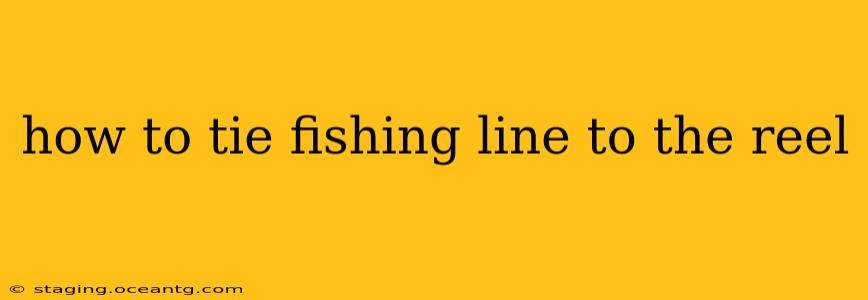Tying fishing line to your reel might seem simple, but doing it correctly is crucial for preventing frustrating line breaks and ensuring successful fishing trips. A secure knot is paramount, not only for landing your catch but also for preventing accidents. This comprehensive guide will walk you through different methods, addressing common questions and offering tips for optimal performance.
What Type of Fishing Line Do You Have?
Before we dive into tying techniques, it's essential to know what type of fishing line you're using. Different lines (monofilament, braided, fluorocarbon) may require slightly different approaches for optimal knot strength. Understanding the properties of your line will help you choose the best knot and ensure a strong connection to your reel.
What Kind of Reel Do You Have?
The type of reel you have – spinning, baitcasting, or spincast – can also influence the best line-tying method. Each reel type has its own nuances, and understanding these will improve your success.
How to Tie Fishing Line to a Spinning Reel
Spinning reels are popular among anglers, and tying the line correctly is crucial. This section details the process:
1. Attaching the Line to the Spool: The Arbor Knot
The most reliable method is the Arbor Knot. This knot secures the line to the reel's spool, preventing slippage and ensuring a firm connection. Here's how to tie it:
- Thread the Line: Pass the fishing line through the hole in the spool of your spinning reel.
- Make a Loop: Create a loop with the line, leaving about 6-8 inches of tag end.
- Wrap the Line: Wrap the tag end around the spool multiple times (at least 5-7). Keep the wraps close together and snug.
- Tuck the Tag End: Tuck the tag end through the initial loop you made, creating a secure knot.
- Tighten: Gently pull the main line to tighten the knot, ensuring it is snug against the spool.
2. Preventing Backlashes and Tangles
Tightly spooling the line onto the reel is critical. Make sure the line is evenly layered on the spool to avoid unwanted backlashes and tangles that can lead to frustration. Avoid overfilling the spool, and always leave some room at the top for potential line expansion when casting.
How to Tie Fishing Line to a Baitcasting Reel
Baitcasting reels demand a different approach compared to spinning reels, prioritizing smooth casting and minimizing backlash. The Arbor Knot is also applicable here:
1. Arbor Knot for Baitcasting Reels
The steps are fundamentally the same as with a spinning reel. However, pay extra attention to ensuring a snug knot and tightly spooled line, as the faster speeds of baitcasting reels can lead to line slippage if the knot isn't perfectly tied.
2. The Importance of Proper Spooling
With baitcasting reels, proper spooling techniques become even more crucial. Uneven line distribution on the spool can significantly increase the risk of backlash and tangles.
How to Tie Fishing Line to a Spincast Reel
Spincast reels are known for their simplicity, but proper line management is still essential. The Arbor Knot remains an effective option:
1. Arbor Knot for Spincast Reels
The steps remain similar to those for spinning and baitcasting reels. Pay attention to the spool's design, ensuring the line sits securely and evenly.
2. Maintaining Smooth Casting
Since spincast reels often have limited line capacity, regular checks for line wear and tear are necessary to avoid casting issues.
What is the Best Knot for Attaching Fishing Line to a Reel?
While other knots can be used, the Arbor Knot is widely considered the best knot for attaching fishing line directly to the spool of a fishing reel due to its simplicity, strength, and reliability. It's easy to learn and consistently provides a secure connection.
How Do I Know If My Line is Properly Attached?
A properly attached line will be firmly seated against the spool and exhibit no significant slippage when gently pulled. The knot should be tight and secure, preventing any movement or looseness.
What Happens If My Line Comes Untied?
Losing your line mid-fishing trip is not only frustrating but can also lead to lost tackle and missed opportunities. Ensure your line is securely attached using a reliable knot and regularly inspect it before and during fishing sessions.
This comprehensive guide should help you confidently tie your fishing line to your reel. Remember, practice makes perfect! The more you practice, the faster and more accurately you'll be able to tie your line, ensuring many successful fishing trips.
